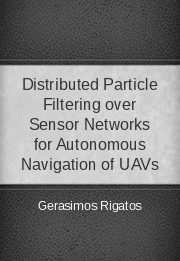Distributed Particle Filtering over Sensor Networks for Autonomous Navigation of UAVs
- / Home
- / Technology Books /

Author: Gerasimos Rigatos
Downloads: 33
Pages: 37
Published: 10 years agoRating: Rated: 0 times Rate It
- 1 star
- 2 stars
- 3 stars
- 4 stars
- 5 stars
Book Description
The paper has examined the problem of localization and autonomous navigation of a multiUAV system based on distributed filtering over sensor networks. Particular emphasis was paid to distributed particle filtering since this decentralized state estimation approach is not constrained by the assumption of noise Gaussian distribution. It was considered that m UAV (helicopter) models are monitored by n different ground stations. The overall concept was that at each monitoring station a filter should be used to track each UAV by fusing measurements which are provided by various UAV sensors, while by fusing the state estimates from the distributed local filters an aggregate state estimate for each UAV should be obtained. The paper proposed first the Extended Information Filter (EIF) and the Unscented Information Filter (UIF) as possible approaches for fusing the state estimates obtained by the local monitoring stations, under the assumption of Gaussian noises. It was shown that the EIF and UIF estimated state vector can be used by a flatness-based controller that makes the UAV follow the desirable trajectory. The Extended Information Filter is a generalization of the Information Filter in which the local filters do not exchange raw measurements but send to an aggregation filter their local information matrices (inverse covariance matrices which can be also associated to the Fisher Information matrices) and their associated local information state vectors (products of the local Information matrices with the local state vectors). In case of nonlinear system dynamics, such as the considered UAV models, the calculation of the information matrices and information state vectors requires the linearization of the local observation equations in the system’s state space description and consequently the computation of Jacobian matrices is needed. In the case of the Unscented Information Filter there is no linearization of the UAVs observation equation. However the application of the Information Filter algorithm is possible through an implicit linearization which is performed by approximating the Jacobian matrix of the system’s output equation by the product of the inverse of the state vector’s covariance matrix (Fisher information matrix) with the cross-covariance matrix

